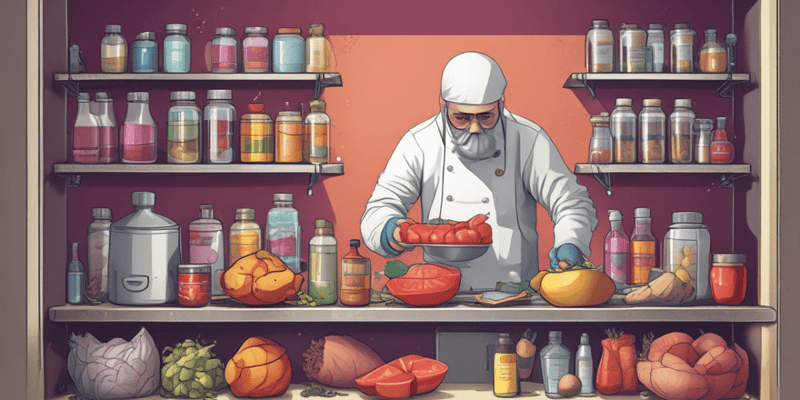Podcast
Questions and Answers
Which fungal species is associated with producing aflatoxins and ochratoxin A in food products?
Which fungal species is associated with producing aflatoxins and ochratoxin A in food products?
What is the most common route of exposure for humans to mycotoxins present in animal-derived products?
What is the most common route of exposure for humans to mycotoxins present in animal-derived products?
Which type of toxins are produced by Fusarium species according to the text?
Which type of toxins are produced by Fusarium species according to the text?
Where are toxin-producing fusarium fungi commonly found geographically?
Where are toxin-producing fusarium fungi commonly found geographically?
Signup and view all the answers
Which type of toxins are considered as important contaminants according to the text?
Which type of toxins are considered as important contaminants according to the text?
Signup and view all the answers
What is the primary source of contamination by mycotoxins according to the text?
What is the primary source of contamination by mycotoxins according to the text?
Signup and view all the answers
What type of contaminants are acrylamide and furan considered as?
What type of contaminants are acrylamide and furan considered as?
Signup and view all the answers
Which of the following is true about heavy metals like mercury and lead?
Which of the following is true about heavy metals like mercury and lead?
Signup and view all the answers
How do heavy metals like mercury and lead enter the food chain?
How do heavy metals like mercury and lead enter the food chain?
Signup and view all the answers
What is one of the health effects associated with lead exposure according to the text?
What is one of the health effects associated with lead exposure according to the text?
Signup and view all the answers
Which of the following contaminants are controlled by legislation in many countries?
Which of the following contaminants are controlled by legislation in many countries?
Signup and view all the answers
What is the primary source of oxytocin in plants according to the text?
What is the primary source of oxytocin in plants according to the text?
Signup and view all the answers
What is the purpose of using growth hormones in the beef cattle industry?
What is the purpose of using growth hormones in the beef cattle industry?
Signup and view all the answers
Where are growth hormones typically implanted in animals for better performance?
Where are growth hormones typically implanted in animals for better performance?
Signup and view all the answers
Which hormone has been reported to be used for increasing the size of pumpkin and vegetables?
Which hormone has been reported to be used for increasing the size of pumpkin and vegetables?
Signup and view all the answers
What type of toxicants are products of the metabolic processes of animals, plants, and microorganisms?
What type of toxicants are products of the metabolic processes of animals, plants, and microorganisms?
Signup and view all the answers
Which common foods contain alkaloids like pyrrolizidine alkaloids and glycoalkaloids that can be toxic to humans?
Which common foods contain alkaloids like pyrrolizidine alkaloids and glycoalkaloids that can be toxic to humans?
Signup and view all the answers
What process does cassava need to go through before consumption due to its content of cyanogenic glucosides?
What process does cassava need to go through before consumption due to its content of cyanogenic glucosides?
Signup and view all the answers
Study Notes
Fungal Species and Mycotoxins
- Aflatoxins and ochratoxin A are produced by Aspergillus species.
- Mycotoxins from animal-derived products mainly enter human exposure through consumption of contaminated food.
Toxins Produced by Fusarium
- Fusarium species produce mycotoxins such as trichothecenes, zearalenone, and fumonisins.
- Toxin-producing Fusarium fungi are primarily found in tropical and subtropical regions, which include parts of Africa, Asia, and the Americas.
Important Contaminants
- Mycotoxins are significant contaminants due to their prevalence in various products.
- Acrylamide and furan are categorized as process contaminants created during food processing and cooking.
Heavy Metals
- Heavy metals like mercury and lead are persistent environmental contaminants affecting food safety.
- They enter the food chain through various pathways, including soil, water pollution, and accumulation in the food web.
Health Effects and Legislation
- Exposure to lead can lead to developmental and neurotoxic effects, particularly in children.
- Mycotoxins and heavy metals are regulated by legislation in many countries to safeguard public health.
Hormones in Agriculture
- The primary source of oxytocin in plants is linked to plant-based diets; however, it is commonly associated with animal care practices for milk production.
- Growth hormones are utilized in the beef cattle industry to enhance growth rates and feed efficiency.
Administration of Growth Hormones
- Hormones are typically implanted in the ear or under the skin of cattle to facilitate better performance and growth.
Toxicants in Agriculture
- Mycotoxins, alkaloids, and other compounds are classified as toxicants arising from the metabolic processes of various organisms.
- Foods like potatoes (glycoalkaloids) and comfrey (pyrrolizidine alkaloids) may contain toxic alkaloids that pose health risks to humans.
Cassava Processing
- Cassava must undergo a process called soaking or fermentation to eliminate cyanogenic glucosides, making it safe for consumption.
Studying That Suits You
Use AI to generate personalized quizzes and flashcards to suit your learning preferences.
Description
Test your knowledge on natural toxins, process contaminants, and environmental chemical contaminants in food. Learn about chemicals like acrylamide, furan, and heavy metals, their sources, and the health risks associated with their consumption.




